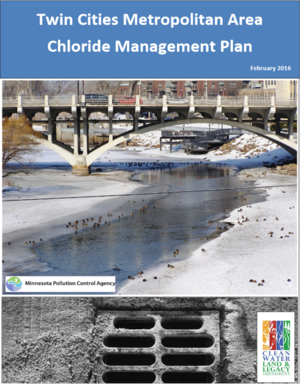
Difference between revisions of "Chloride Management Plan"
m |
m |
||
| Line 21: | Line 21: | ||
*[[TCMA Chloride Management Plan - Appendix D – Educational Resources]] | *[[TCMA Chloride Management Plan - Appendix D – Educational Resources]] | ||
*[[TCMA Chloride Management Plan - References]] | *[[TCMA Chloride Management Plan - References]] | ||
| + | |||
| + | [[Category:Level 2 - Pollutants/Chloride]] | ||
| + | [[Category:Level 2 - Management/Winter management]] | ||
Latest revision as of 16:21, 23 November 2022
There are two primary sources of chloride to the Twin Cities Metropolitan Area (TCMA) water resources: 1) salt applied to roads, parking lots and sidewalks for deicing; and 2) water softener brine discharges to municipal wastewater treatment plants (WWTPs). The Minnesota Pollution Control Agency (MPCA) worked with stakeholders in the Seven County Twin Cities Metropolitan Area (TCMA) to assess the level of chloride in water resources and to develop a plan to restore and protect waters impacted by chloride. This Chloride Management Plan (CMP) incorporates water quality assessment, source identification, implementation strategies, monitoring recommendations, and measurement and tracking of results into a performance-based adaptive approach for the TCMA.
The goal of this plan is to develop the framework to assist local partners in minimizing salt (chloride) use and provide safe and desirable conditions for the public. The plan highlights the impacts of chloride on TCMA water quality, helps develop an appreciation of the competing demands of level of service and reduced salt usage, sets performance-based goals for restoration and protection, informs and guides implementation of improved winter maintenance practices and policy needs, and demonstrates the success and economic benefits of improved practices. The report includes information on the status and trends of chloride levels in lakes, wetlands, streams and groundwater, sources of chloride, restoration and protection goals, implementation strategies to reduce chloride impacts, educational and training resources, and continued monitoring, tracking, and adaptive management. The audiences for this document include local working groups (local governments, watershed management groups, etc.), winter maintenance groups (MnDOT, local governments, private applicators, commercial property owners, residents, etc.), elected officials and policy-makers, and state agencies (MPCA, MnDOT, DNR, BWSR, etc.)
To view the following pages as a single document link here or here.
- TCMA Chloride Management Plan - Background and Description
- TCMA Chloride Management Plan - TCMA Chloride Conditions
- TCMA Chloride Management Plan - Prioritizing and Implementing Restoration and Protection
- TCMA Chloride Management Plan - Monitoring, tracking, reporting, and adaptive management
- TCMA Chloride Management Plan - Research Needs
- TCMA Chloride Management Plan - Stakeholder and Public Involvement Process
- TCMA Chloride Management Plan - Appendix A – TCMA Chloride TMDL
- TCMA Chloride Management Plan - Appendix B – Winter Maintenance Assessment tool (WMAt)
- TCMA Chloride Management Plan - Appendix C – Sidewalk Survey Results
- TCMA Chloride Management Plan - Appendix D – Educational Resources
- TCMA Chloride Management Plan - References
This page was last edited on 23 November 2022, at 16:21.
